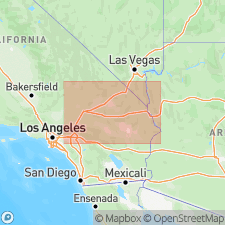
- Usage in publication:
-
- Avawatz formation
- Modifications:
-
- Original reference
- Dominant lithology:
-
- Conglomerate
- Clay
- Breccia
- Sandstone
- Tuff
- AAPG geologic province:
-
- Sierra Nevada province
Summary:
Pg. 5-7, 8, 16 [1939 preprint]. Avawatz formation. Proposed to include Tertiary series of sedimentary rocks which lie immediately to south and west of eastern end of Avawatz Mountains. Roughly divided into four members: a coarse conglomerate (fanglomerate); green and brown clays (lake beds); resistant breccia (atmoclastic breccia); and arkosic sands and tuffs (fluviatile deposits). Overlies basement complex of metamorphic and plutonic rocks; unconformably underlies a coarse conglomerate believed to be Quaternary in age. Thickness over 1,000 feet, possibly several thousands of feet. Age is early Pliocene.
Type area: Avawatz Mountains quadrangle, southeastern CA. Fossil locality lies on southeasternmost flank of Avawatz Mountains, 10 mi by road northwesterly from town of Silver Lake on Tonopah and Tidewater RR, San Bernardino Co., southeastern CA.
Source: US geologic names lexicon (USGS Bull. 1200, p. 177).
- Usage in publication:
-
- Avawatz Formation
- Modifications:
-
- Age modified
Lofgren, D.L., Greening, J.A., Johnson, C.F., Lewis, S.J., and Torres, M.A., 2006, Fossil tracks at the Raymond Alf Museum of Paleontology and management of tracks on public lands: New Mexico Museum of Natural History and Science Bulletin, no. 34, p. 109-118.
Summary:
Pg. 113-114; see also references therein. Avawatz Formation. Coarse- to fine-grained tuffaceous sedimentary rocks interbedded with distinct white to buff colored volcanic ashes a meter+ thick. Upper part of formation contains hundreds of vertebrate fossil tracks (notably birds, camels, felids). Age is late Miocene (Clarendonian NALMA).
Source: Publication.
For more information, please contact Nancy Stamm, Geologic Names Committee Secretary.
Asterisk (*) indicates published by U.S. Geological Survey authors.
"No current usage" (†) implies that a name has been abandoned or has fallen into disuse. Former usage and, if known, replacement name given in parentheses ( ).
Slash (/) indicates name conflicts with nomenclatural guidelines (CSN, 1933; ACSN, 1961, 1970; NACSN, 1983, 2005, 2021). May be explained within brackets ([ ]).

